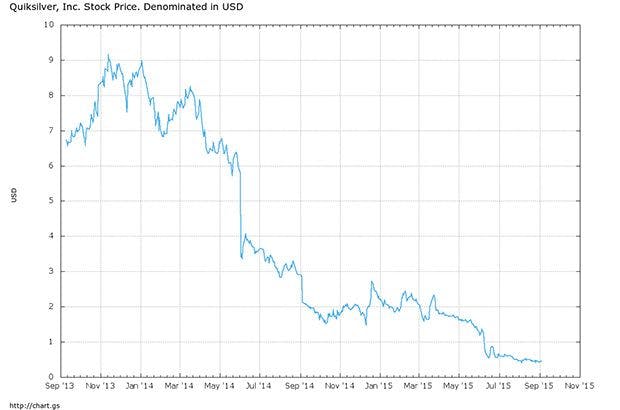surf industry newsDown But Not Out: Quiksilver Files for Bankruptcy

Quiksilver, one of the most iconic brands in the surf world, has filed for Chapter 11 bankruptcy in the U.S.
It’s big news in an industry that has fallen on tough times and seen other major players experience heavy losses in recent years, however consumers are unlikely to notice a thing; Quiksilver and it’s sibling brands Roxy and DC aren’t going anywhere, this is just the latest stage (and a very headline grabbing one) in an ongoing internal restructuring of the business. The chapter 11 filing is only for Quiksilver’s U.S. operations, as its European and Asia-Pacific businesses remain strong, and account for over half of the brand’s sales.
In March of this year there was a shake-up and shuffle around of the company’s top-tier executives with Andrew Mooney, the former chairman of consumer products at Disney Co. who replaced founder Bob McKnight as CEO in January 2013, leaving to be replaced by the president Pierre Agnes, and CFO Richard Shields being replaced by Quiksilver Europe’s CFO Thomas Chambolle. Quiksilver have been posting annual losses since 2007 following rapid expansion (including the acquisition of ski brand Rossignol) through the early 2000s, and reported a 13% decline in sales last year with a net loss of $309.4 million. This year, Quiksilver has lost 79% of its market value. In June they announced that they were scrapping their annual earnings forecast and in July the New York Stock Exchange warned that the company could be de-listed (it was first listed on the NYSE in 1986) due to the low value of its stock. When Quiksilver filed for voluntary bankruptcy it reportedly listed assets of over $100 million and liabilities of more than $500 million.

Graph showing Quiksilver Inc.’s stock price in USD from September 2013 to September 2015
Bloomberg reported last week that Quiksilver Inc. was seeking a buyer, with the preferred option being a management buyout, however it was expected to be an unappealing proposition and that filing for bankruptcy would provide a better option and make the company more attractive to a potential investor. That investor is Oaktree Capital Management, an investment firm who are (subject to approval by the Bankruptcy Court) providing $175 million in debtor-in-possession financing which will convert into a majority stake in the restructured company when it emergences from bankruptcy. Oaktree specialises in alternative investments and manages over $100 billion in assets. The firm has a history of investment in the action sports industry, also holding a significant stake in Billabong International Ltd. following the Australian brand’s refinancing in 2013.
“After careful consideration, we have taken this difficult but necessary step to secure a bright future for Quiksilver,” said Pierre Agnes, Chief Executive Officer of Quiksilver. “With the protections afforded by the Bankruptcy Code and the financing provided by Oaktree, we will not only be able to satisfy our ongoing obligations to customers, vendors and employees, but we will also have the flexibility needed to complete the turnaround of our U.S. operations and re-establish Quiksilver as the leader in the action sports industry. Our fresh capital structure, with a very low level of debt for our industry, will enable us to invest in and reinvigorate our brands and products. We are confident we will emerge a stronger business, better positioned to grow and prosper into the future.”
Following its filing for bankruptcy, Quiksilver will continue its existing store closure programme across the U.S. however consumers are unlikely to notice any great differences; the company has been cutting back for several years now, closing down a number of sibling brands (such as VSTR, the Waterman Collection and Quiksilver Women), pulling Quiksilver and Roxy out of the skate market and DC out of the surf market, and cutting large numbers of sponsored athletes – an act that survivor Dane Reynolds referred to as “a massacre” at the 2013 Surfer Poll. The Quiksilver Crossing, bro boat trips to the Ments and Kelly Slater riding with the mountain and the wave emblazoned on the nose of his board were all things of the past anyway (Kelly left Quiksilver of his own volition after 23 years in spring of 2013), regardless of this latest development. Core events such as the Quiksilver Pro in Hossegor at the start of next month will run as planned, and Steph, Dane and Jeremy can probably all sleep easy, which at the end of the day is all that most surfers are interested in. Quiksilver has come along way from its boardshort beginnings in 1969, growing into an international apparel brand that capitalised on the popularity of surf and skate fashion through the 1990s and early 2000s. Their investment in surfing was significant through this period, however it could be argued that many core surfers had already disengaged with the brand before it began to suffer the effects of a competitive fashion retail industry and broader economic downturns. We just wanted them to put on contests and finance pro-surfers’ exotic trips, providing us with photos, films and magazine articles to pore over. Hopefully, when this is all done and dusted, they can get back to business and we can reap the benefits. Like them or loathe them, Quiksilver is an iconic company within surfing, and it’d be a shame to lose them.